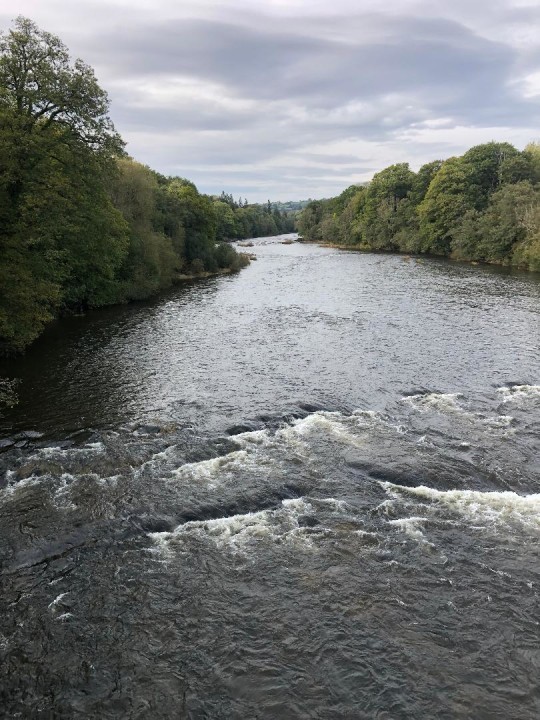 High water Gromaine - HB from London
High water Gromaine - HB from London “The weather has the potential to do something, but then again it may decide not to, or perhaps do something different.” I usually start my day by reading the weather forecast, but why did I get the impression on 2nd October that Metcheck’s weather man had yawned sleepily, typed the above sentence on his lap top and then rolled back under the covers for a duvet day? I suppose that’s what working from home does for you. Truly October had started with rather indeterminate weather to confuse even a weather man, warmer than expected for the season, with some showers around which just missed us here on the Severn estuary, but which clearly had a big effect further up in Wales. Accordingly both Wye and Usk were now again in flood. Turning then to the reports received from the previous weekend, I saw that on 29th September with the Wye already rising RP from Hertfordshire had 3 barbel to 9.25 pounds and 16 chub from Fownhope 5. Meanwhile MD from Barry had this comment to make about his salmon fishing on the Usk at Abercynrig:
“It’s been 15 years since I first went to Abercynrig, then Dinas and Abercynrig. I’ll never forget that day; late September during my last-ditch trout fishing for the year, when the river rose, and I saw my first salmon run. There were fish running through and we had maybe 40 or 50 sightings. It was that day that led me to become a salmon fisherman. Here we are, years later, and today I did not see a single salmon. The water was quite high but dropping and, in this respect, good for salmon, but nothing. I think it’s wrong to even bother trying.”
MD’s report amounts to a rather sad comment and I was sorry to read it. I was out myself that morning, on the lower Usk at Kemys Commander, and I didn’t see one either. However, IN from Llanelli did see a silver salmon roll up at Cefn Rhosan Fawr. All is not quite lost. And James MacMillan caught a fish of 10 pounds from the Lady Stream at Glanwye the following day. Interestingly MB from Rhayader was also salmon fishing up at Doldowlod. He didn’t touch a salmon but he did take a brown trout of 4 pounds on the last day of the trout season. That part of the Wye has long had a reputation for the occasional very large brown trout – at the beginning of the 20th century Augustus Grimble in his salmon fishery survey inaccurately described these as bull trout. Doldowlod Common was then considered about the top of the Wye’s practical salmon fishing range and springers averaging 18 pounds were in place as early as January. Those were the days!
GC from Pontypridd fished the Breconshire Fishery in slightly coloured water and caught 12 trout, mostly on streamers. SP from Warwick reported 17 trout from Llyn Bugeilyn, taken from just under and on the surface with patterns including Coch y Bonddu, the red and black beetle imitation. On 1st October M from Suffolk blanked on the rising Wye at Foy Bridge, but recommended overnighting at “Stay by the Wye” which offers guests a lockable tackle store. PP from Pitstone must have been ahead of the flood lower downstream and cheerfully reported “Good fun at Wyebank,” where he caught a dozen barbel between 2 and 5 pounds along with a couple of chub. With levels many feet above normal, coarse anglers were still catching while using 5 ounce leads just about able to hold the bottom off the main current. WM from Stroud reported a great day on Middle Hill Court although the river was muddy and still rising: “It’s not always like this.” He caught 7 barbel finishing with a double figure fish which he played on into gathering darkness. I’m sure he will remember that evening. A team of four from Leeds led by SC had 24 barbel to 10 pounds 2 ounces along with 22 chub at Fownhope 5. The following day at Middle Hill Court they again had 24 barbel between them, plus 7 chub. On the 4th with the lower Usk still fairly high, Stuart Macoustra caught a salmon of 10 pounds on a Conehead Cascade at Newbridge. A better fish was lost. His report from the following day gives good advice about fishing at Chainbridge, including fishing the Cables. The Wye was higher, but JR from Sandon had a very good day on the Dean and Chapter Pool, catching 4 barbel to 9 pounds 12 ounces and 45 chub to nearly 6 pounds. SC from Leeds had 2 barbel and 17 chub from The Creel. Meanwhile, one of our grayling regulars, AG from Harleston in Norfolk was trying his luck on the Tees this year at the Darlington Brown Trout AA’s North Bank water. He had a few but found the river rather daunting, 80 yards across in places “and the bed is all made up of football size rocks.” On 6th October SM from Westcliff on Sea had a couple of grayling along with the barbel and chub in his catch at Caradoc. They do turn up sometimes in the lower river. PP from Pitstone finished his week’s holiday with us on Middle Hill Court and caught 5 barbel and 20 chub on both float and feeder. Daniel Edwards from Neath was fishing for salmon at Goodrich Court and caught one from the Maddox. That is in fact the only salmon landed at Goodrich this year. Glanwye reported a 13 pounds hen while Steve Boswell fishing at Lower Glanwye had a cock fish of 16 pounds on a size 8 Bann Special.
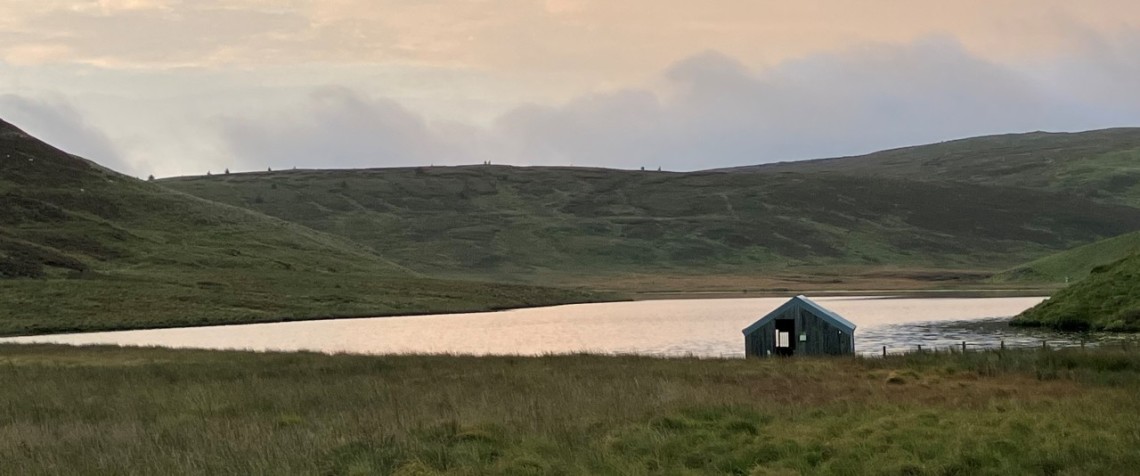 Llyn Bugeilyn - SP from Wawick
Llyn Bugeilyn - SP from Wawick On 7th October NC from Wiltshire had 14 barbel and 2 chub at Courtfield. My pal Lyn Davies from Swansea was in a quandary about where to fish for grayling, the water still being high on the main river after more showers the previous day. The Irfon was an obvious choice, but, like me, he has concerns about the grayling population on the Irfon these days. He opted for the Colonel’s Water, although I suggested he would probably get just the one or maybe two big grayling. So it proved: he reported a single 17 inch grayling and 14 out of season trout to 15 inches. Lyn is a hell of a fisherman; he doesn’t miss much, and I am left with the thought that it would be good to see some more small and medium sized grayling on these Irfon beats. RB from Bromyard made an exploratory visit to the Teme at Newnham Farm and discovered with surprised pleasure that there is a winery and bistro on site (open Wednesday to Saturday).
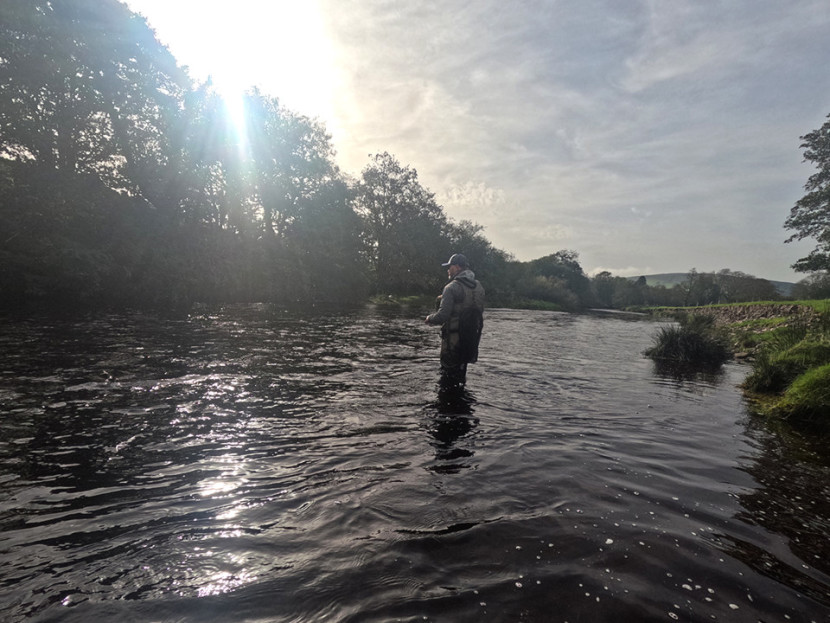 Colonel's Water - Lyn Davies
Colonel's Water - Lyn Davies 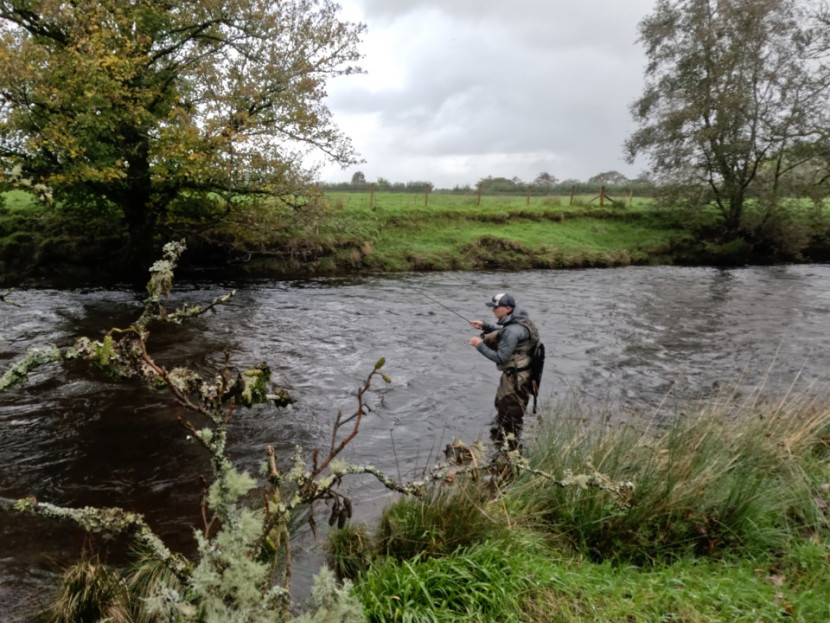 Melyn Cildu - Lyn Davies
Melyn Cildu - Lyn Davies 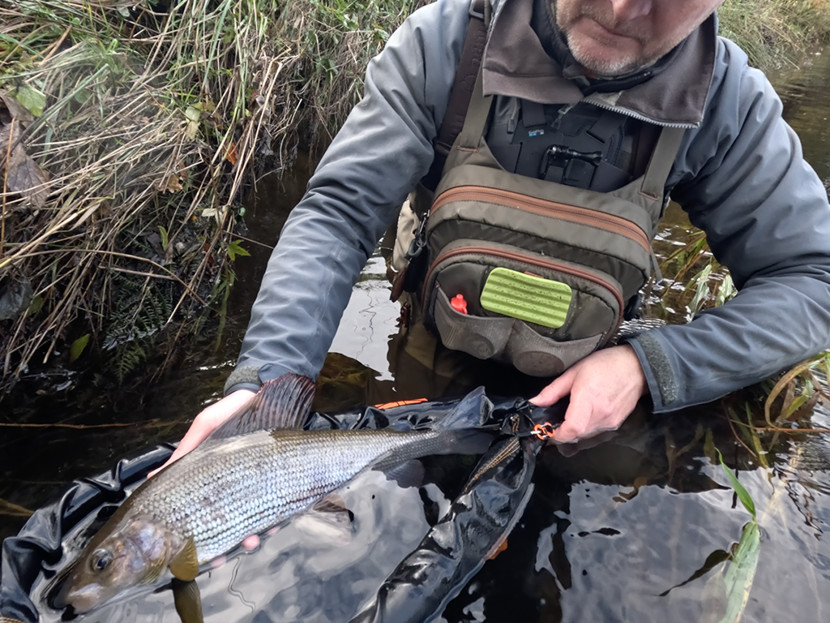 Upper Irfon - Lyn Davies
Upper Irfon - Lyn Davies By the 9th, Wyesham reported salmon of 11 and 16 pounds, with another of 7 pounds on the 10th. RR from Bridgend pointed out the presence of sprat dead-baits on the bank of Wyastone Leys – there is supposed to be no pike fishing here. That was followed for him by a pleasing day at Upper Breinton, with 6 barbel to 10 pounds 4 ounces and 4 chub to 6 pounds. DM from Leatherhead with 3 friends caught 8 barbel and 8 chub from Middle Hill Court and recommended finishing the day at Walford’s Mill-Race restaurant: “…proper food.” Over on the Aberystwyth AA’s water of the Rheidol, MH from Taff Wells caught a good sea trout, while Richard Godsall reported salmon of 11 pounds and 35 inches from the Wye at Glanwye. Mark Purvis of Chipping Norton sent in a photograph of a fine harvest salmon of 18 pounds from the Dolmeudw pool of Upper Llanstephan – “one for Stephen” indeed. PF from Abingdon fished at Courtfield and picked up 3 eels, one of which he thought might weigh 3 pounds. He reminded himself not to fish luncheon meat in future. MF from Coventry caught a 32 inch coloured hen salmon on a small Willie Gunn tube at Cadora Backs. This is Maurice Hudson’s lower Wye beat and MF thought it looked rather overgrown and indeed unfished this season, which if true I’m sorry to hear. With the river rising again, KE from Barnstaple had a fine pair of barbel from the Dean and Chapter Pool, weighing 10 pounds 1 ounce and 8 pounds 9 ounce.
While we were distracted by a new war in the Middle East, a tremendous amount of rain fell during the night of 12th October, and all rivers were in flood by the 13th. Coarse fishermen pressed on with floodwater fishing in the slacks for barbel and chub, but there wasn’t much for the game fishers for a while. On 17th October, last day of the salmon season, the upper parts only of both rivers, first the Usk and then the Wye, came into something like condition. Mark Harris, who had tried the Usk at the Rookery a couple of days before, had a cock fish of 17 pounds on a Red Devil tube from the Rectory: “You said to go up and see if one would come from the Rock Pool, Louis, but he took a bit further up in the Island Stream.” There was a 10 pounds hen salmon from the Cafn Stream of the Nyth. A little lower down the Wye, Ed Brown had two from the Grange Pool at Spreadeagle. Some late October reports came in: 3 for the Rocks and 4 for Bigsweir. And that, as they say, was that – at least for the salmon of 2023. There will no doubt be some more late reports and a few missed, but for now it looks like we are finishing on 223 fish.
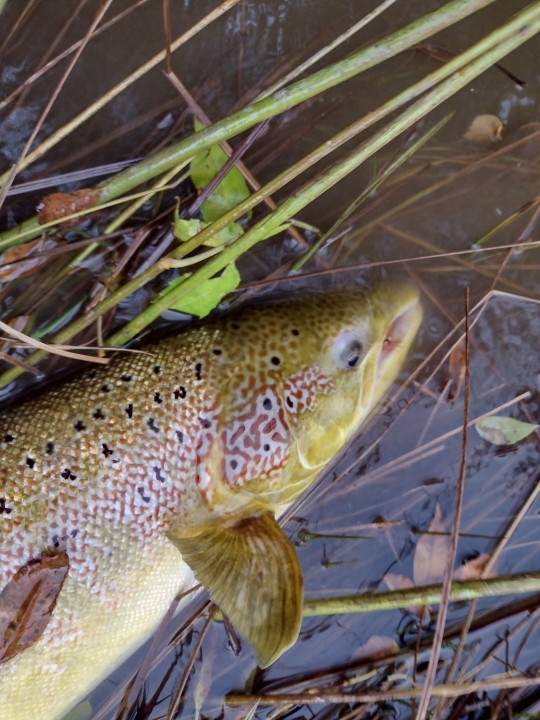 Dolmeudw, one for Stephen - MP from Chipping Norton
Dolmeudw, one for Stephen - MP from Chipping Norton Along came Storm Babet, with serious consequences for property and even for life in the North. We missed the very heavy winds, but the rain put all the rivers of the Welsh Marches right back into flood. As it happened my son Malcolm and I had a boat booked on Blagdon Lake, which for me in October was more an act of pilgrimage than an indication of great expectations. I have always had a soft spot for Blagdon ever since reading Harry Plunket Greene’s description of it in my youth. Romantic Irishman that he was, Plunket Greene had a talent for making magic out of landscapes. Still, this day would be grim if they let the boats out at all, I thought to myself when I saw the storm forecast. But as it turned out the winds were moderate, producing no more than a mild chop and the rain came only in brief showers interrupted by sunlight. We were the only boat out, so we had the beautiful Blagdon Lake to drift by ourselves. A double rainbow came and went over Butcombe Bay as the day went on. The fishing was anything but busy, but Malcolm managed to finesse a pretty little rainbow trout from the weed beds in Pipe Bay.
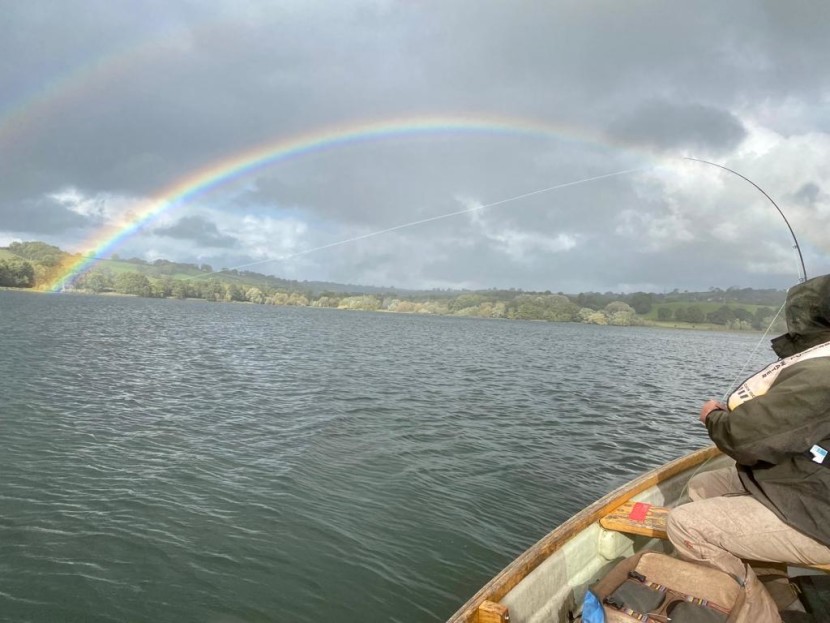 The magic of Blagdon
The magic of Blagdon 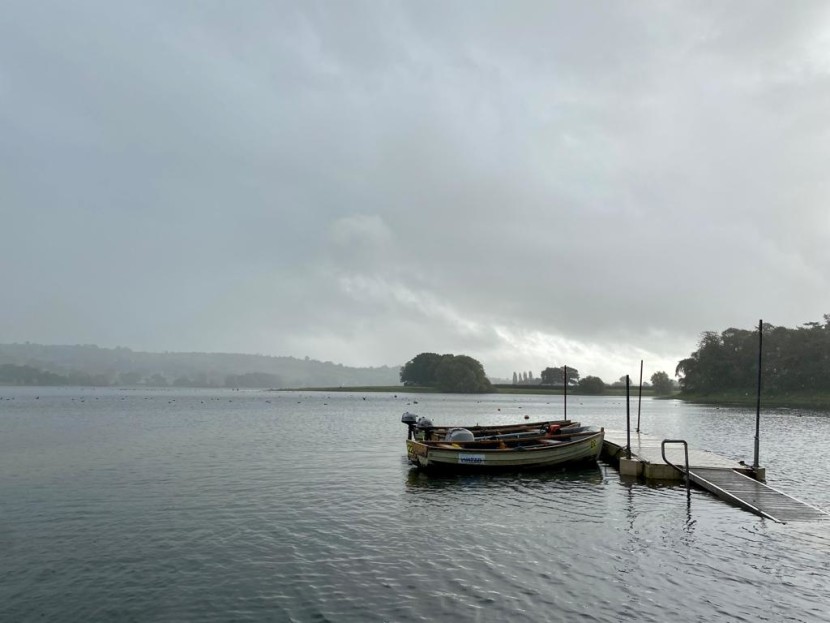 Morning launch during Babet
Morning launch during Babet On the 17th October PL from Trevor Llangollen reported 80 trout on “bait maggots” on the SGLL Fishing Society water of Llyn Padarn. I hope that is a mistype, because the daily catch limit is 8! Perhaps this was the angler’s season total. Padarn is a very special natural lake, known also for its char, and you will recall there have been past concerns over pollution there. Many autumn coarse fishers were booked on the Wye during the Storm Babet spate; quite a few considered the conditions too extreme or dangerous and headed home; others still managed to fish in slacks with heavy ledger weights or feeders and most of these had some kind of a result. LS from Stevenage with a friend had a holiday booked, starting with The Creel on 20th October where they caught 15 barbel and 5 chub: “…love a bit of high water fishing.” On the 21st they were at How Caple where they caught 10 barbel to 11 pounds 8 ounces, plus 11 chub. A third day at the same beat resulted in 16 barbel and 17 chub: “…levels dropping throughout the day…chocolate colour.” Another day on the Creel earned them 8 barbel and 4 chub.
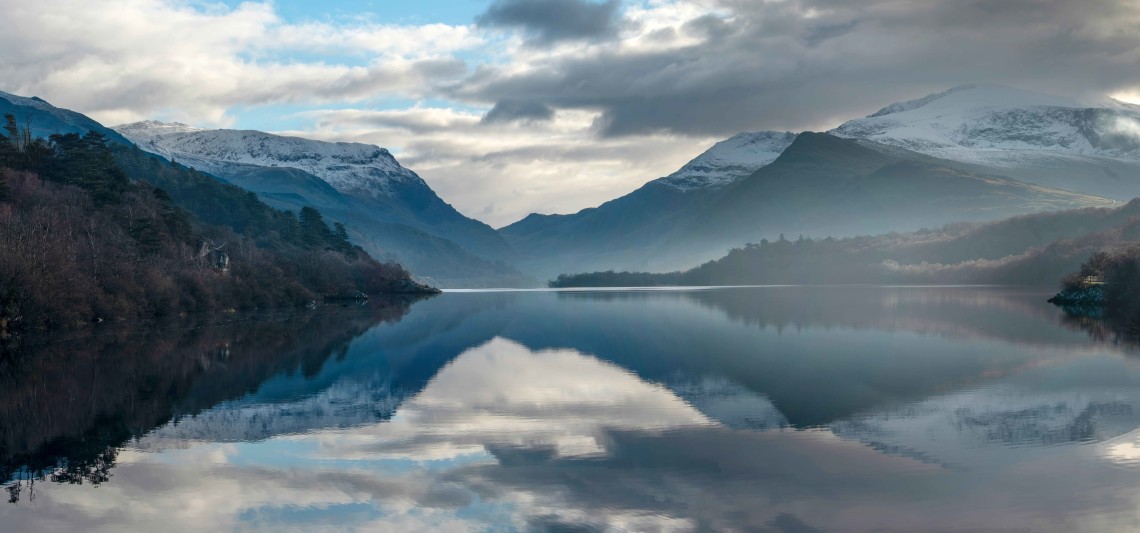 Llyn Padarn
Llyn Padarn 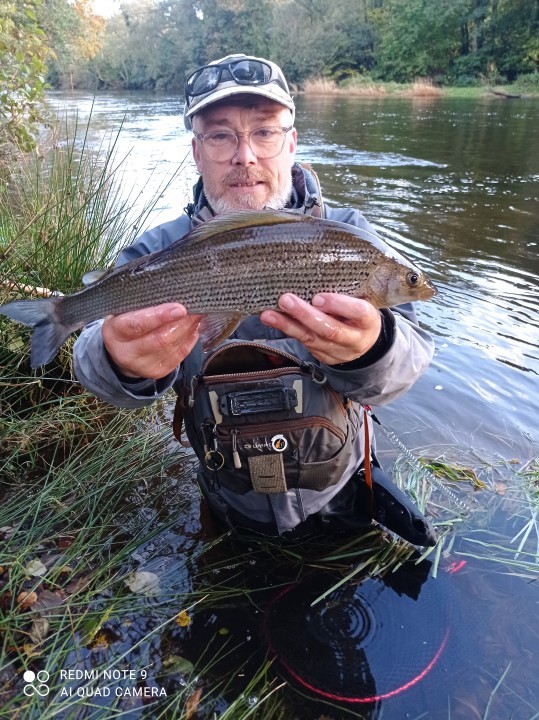 Craig Llyn - GR from Newbridge
Craig Llyn - GR from Newbridge BR from Crawley with two friends fishing at Lower Canon Bridge was surprised to catch an out of season brown trout on ledgered meat. Believe me BR, trout will eat almost anything. I saw one eat a cigarette butt once. Grayling anglers were left without opportunities for a few days, but as levels began to drop Lyn Davies managed to find fishable water by going far up the Irfon again to Melyn Cildu. The result was a 17.5 inch grayling, but again just a single fish. Interestingly, GR from Newbridge with a friend fished the top of the Wye at Clochfaen for a single grayling and 9 out of season trout. Next day they were on the Colonel’s Water of the Irfon and they had just the one grayling with 26 out of season trout. And on the 23rd three of them fished back on the Wye at Craig Llyn, this time for 28 grayling and 13 out of season trout. One worries about fluctuations of the grayling population in different parts of the river and in different tributaries, but sometimes there seems to be no accounting for it. This is not exactly a new story and usually the populations rebuild over time.
On the 26th GM from Shrewsbury blanked for grayling at Clochfaen, but he did report an out of season salmon and 2 out of season trout. TT from Tillingham fished at How Caple Court and took 6 chub, along with an out of season salmon of 10 pounds. This one took a paste-wrapped boilie fished on leger tackle, presumably scenting it through the flood water as they used to do with a bunch of worms back in the day.
More rain followed and higher water than ever over the weekend. With the ground quite saturated, we had reached a state where every new shower seemed to run straight into the river. Barbel and chub could still be caught. GL from Abergavenny reported 2 barbel and 12 chub from Lower Redbank 1 and SC from Leeds with a friend reported 15 barbel and a chub from Middle Hill Court. RE from Cwmbran fishing at Goodrich Court, obviously concerned above all to be helpful to his fellow anglers, reported that barbel could only be caught there on “one obscure bait.” Elsewhere he described the magic bait as “one strange concoction.” I must ask my local tackle shop to see if they stock it. The month ended with more rain and floods.
There was much embarrassment in Ottawa last month. Ukrainian President Zelenski came to town on one of his regular tours around the NATO countries looking for more armaments and financial support. As is usual everywhere he was invited to address Parliament and as usual he received a standing ovation. After which Canadian Speaker Anthony Rota stood up to explain that on his personal initiative he had invited another Ukrainian hero to the House, one of his own constituents named Yaroslav Hunka, now 98 years old, who had once fought for Ukrainian independence against the Russians in World War II: “…a Ukrainian hero, a Canadian hero. We thank him for all his service.” There followed another standing ovation while the elderly Yaroslav stood up in the gallery and gave a sort of awkward bow. What a nice surprise for everybody, heroes everywhere and the applause was rapturous!
It was shortly afterwards that somebody with a more inquiring mind dug a little deeper and pointed out that the unit which Yaroslav had joined in 1943 was Himmler’s 14th Waffen SS Grenadier Division which after action both in the East and the West later surrendered to the Allies as the First Ukrainian Division. Yaroslav had fought the Russians alright, and probably the Americans, British and Canadians too. At any rate, he had certainly done his bit for the Axis Powers. All the smiles on all the faces must have frozen. The Speaker was mortified, apologised profusely and eventually had to resign. Voices in Poland began to speak of extraditing Mr Hunka. There are no known charges against him from WW2, although the repressive activities against civilians of the Division as a whole were of considerable interest to the Nuremburg Tribunal. German SS officers posted to Eastern Europe were said to have been quite shocked at the depths to which the local wartime recruits were prepared to descend. Mr Hunka’s family had apparently donated 30,000 dollars to the Canadian Institute of Ukrainian Studies – what was to be done about that? The affair was described as Canada’s greatest diplomatic blunder ever.
Moscow, which sells the present Ukrainian War to the Russian population as a crusade against Nazism, was understandably delighted with this propaganda gift. A spokesman reacted to the news with the off-cuff remark: “It seems that the West deliberately do not educate their young people about what happened in World War II.” Today there are streets in Ukraine named after the First Division and the anniversary of the Division’s foundation is publicly commemorated on 28th April with a march through Lviv. It strikes me that Moscow’s spokesman may have a point.
Far away in Herzegovina there is a village by a blue-green limestone stream which rather curiously has meant different things at different periods to both my wife and myself. Blagaj - you pronounce it Blag-eye - for Nerma is the native village of her mother’s parents. This is the country home where she spent the summer holidays of childhood, staying with her grandparents in their old Turkish house enclosing a courtyard and built against the wall of the mosque. Blagaj village itself is an ancient settlement, in fact older by far than nearby Mostar city (which was founded by the Ottomans in the 16th century) and sited on the “source” of the freezing cold River Buna, which pours from a dark cave at the foot of limestone cliffs. Thousands of feet above, where griffon vultures wheel, are the ruined castle walls of medieval Blagaj Fortress.
Old people who remember the decades which followed World War II still call them the golden age of Tito’s Yugoslavia. Nerma has the happiest memories of childhood life in the village with her grandmother, who was a religious country-woman of the traditional kind. The morning would be occupied in making bread and churning butter, or Nerma would take Martin the donkey with panniers to the market to pick up discarded scraps of vegetables for the cows. In the heat of the afternoon she and her grandmother would carry a tray of coffee and biscuits down through the garden, past the growing peppers and beans, to sit together in the shade of a giant fig tree. There her grandmother would sit quietly, smoking away from the gaze of her husband and saluted by every passer-by: Selam alaikum. Sometimes Nerma would get a coin to spend on a small ice cream in the shop round the corner.
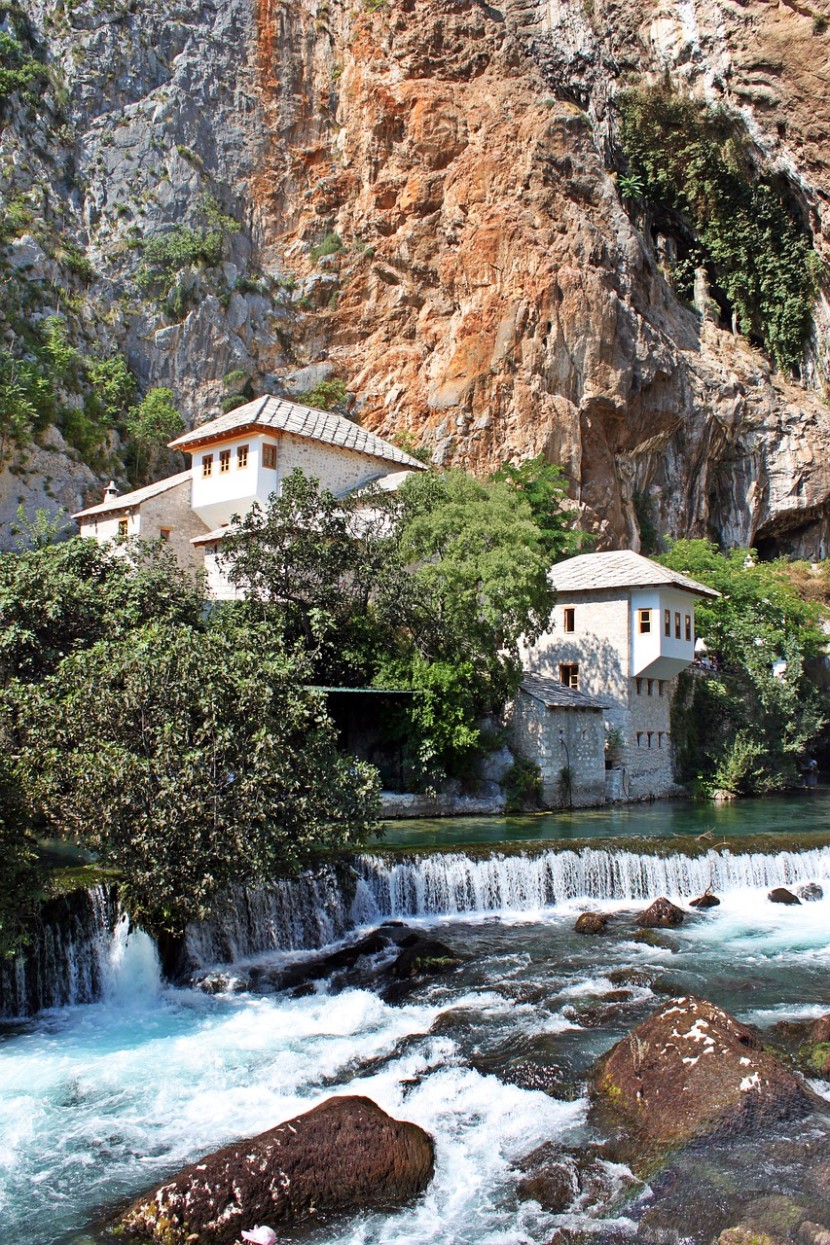 Blagaj and Tekija by the Buna
Blagaj and Tekija by the Buna Nerma’s uncle Sulejman, his teenaged wife Hatidza and sons Enver and Mustafa also lived in the family home. The family and especially Nerma’s grandmother were well liked in Blagai, but her grandfather, the village butcher, was a much more distant and even feared figure. He spent most of his time in his shop or smoking upstairs at home, sitting and brooding with a little ibrik of black coffee. Cardak is the name for those projecting upper storeys with wooden screens from which the street could be observed unseen. You didn’t bandy words with the butcher of Blagaj who was famous for being able to slaughter a steer single handed. A dark, angry looking man who always wore a heavy black coat slung across his shoulders, he was also known for poaching fish with dynamite and nets. A typical story about him involves a young man who came to his shop and spoke with great respect: “Forgive me Grandpa Saric, you know my family, but I need work, I need a skill. May I offer to work for you without pay for two years if you will be kind enough to teach me the butchery trade?” The old man’s response was to take his largest knife down from the wall and chase the young man down the cobbled street while shouting: “There’s only one butcher in Blagaj and that is me.” People afterwards said that the young fellow should have had more sense.
The Buna here is only a short river as it runs down to the Neretva, but it is strong and clean so that there are water mills and even a trout farm in Blagaj. Riverside pastures and fields are fertile. More famously, besides the cave from which the Buna flows are the Tekija, mausoleum tombs of dervish saints. There is a legend that a pan of water left beside the tombs will be dry in the morning, presumably drunk off by their ghosts. As a teenager dressed up in the traditional Turkish dimija trousers and embroidered jacket, Nerma served coffee and cubes of loukoumi delight to tourists who would visit the tombs. However, at certain times of the year religious dervishes from all over Bosnia would gather here for festivals. These slightly frightening occasions were for men only, and strange rituals, more of magic than religion, reportedly occurred to the hypnotic beat of drums while hot coals would be walked on bare foot or skewers thrust through cheeks.
For a young girl growing up in a Communist workers’ state where religion was tolerated but folklore and tradition were actively encouraged, the future looked surprisingly open. Her father drove a truck and her mother was a seamstress; they lived in a modern apartment block in Mostar city, although the traditions of the village and the older generation were also close at hand. When Nerma was 10 years old, as a child pianist she had been the one chosen by the Party to present Comrade Tito with a bunch of flowers when he came to visit Mostar. Later she went to Sarajevo University to study English Literature and sat on the committee of the 1984 Winter Olympics. She became a teacher and then a music school principal. After Tito’s death, the mood of the country changed as corruption and inflation followed and she became very aware of the gathering clouds of nationalism. She liked at that time to collect paintings from local artists and one of these in particular impressed me. A still life of pomegranate seeds against dark red curtains, it has a backdrop of the city threatened by a lowering sky which always seemed to me to be a premonition of sinister happenings. It reminds me of El Greco’s Toledo and I think we still have that picture in the flat, one of the few Muslim-owned apartments now left in West Mostar.
Blagaj in wartime was perhaps the most dangerous place in the Mostar area, packed with ragged Muslim soldiers and refugees from all over Herzegovina. The Serbian and Croatian populations had fled. Eventually the village found itself at the southern point of a triangle of territory still controlled by the Bosnian Government. On one side was the line against Bosnian Croat forces across the burned out vineyards of Mostarsko Polje; the mountains and crags directly above on the other side were held by the Bosnian Serb army and they shelled at will. The big guns up at Nevesinje were ranged on Mostar, but little 76 millimetre mountain guns and mortars could pick out closer targets with unnerving accuracy. I think my first visit was in early 1994, just after the end of the Muslim-Croat war and a cease fire which was more honoured in the breach than the observance. The Serbs still shelled the other two factions whenever they felt like it or according to payments made. The tarmac road into Blagaj across the plain was then too exposed for safety so I took my Landrover in by the so-called Partisan Road, a rough track built close under the mountains by the Mostar Brigade, and I found Nerma’s cousin Mustafa on the first checkpoint.
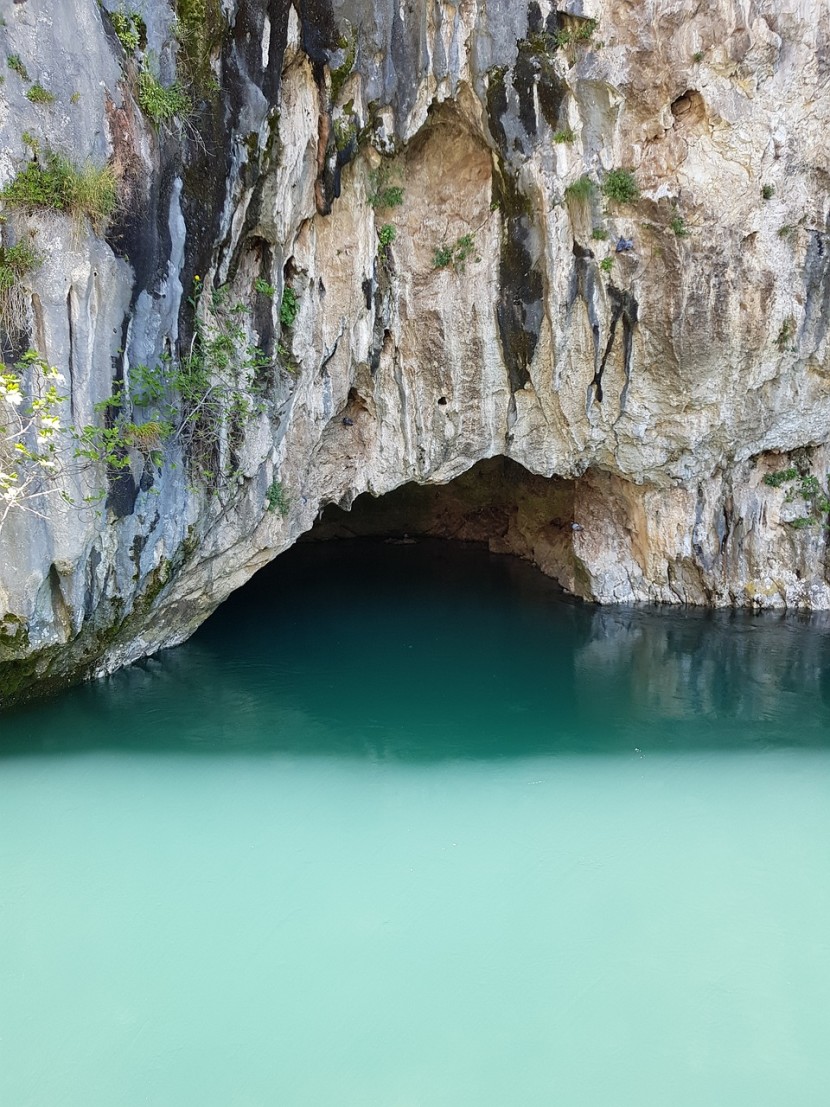 Buna cave source at Blagaj
Buna cave source at Blagaj Once arrived in Blagaj, I had a parcel from his family abroad to deliver to one of the doctors at the clinic. He took a break from his patients and we went out in the sunshine to where heavy baulks of timber were propped over the windows to protect them from shrapnel and opened one of the packets of cigarettes from the parcel. The doctor was young, but with a dark, deeply-lined face and he smoked through one of the long ivory holders men affect in Mostar. He was polite, not unfriendly, but in a cynical mood. This became expected. Given what they had to deal with on a daily basis, I found Bosnian medics usually were pretty cynical as the only way to get by.
“What do you think of the situation?” I asked him.
“The situation? Well, I think another 10 years fighting should do it. What are they saying outside?”
Nerma’s grandparents had both died long before the war, but Sulejman and his family continued to live in the old house by the mosque, protected now with timber and with plastic in the windows. Sulejman and his sons Enver and Mustafa were all enlisted in the Mostar Brigade. Later, when we had the humanitarian bakery in East Mostar, most of the bread went into the city but we delivered a van load of fresh loaves every day to Blagaj. We had to swap the delivery point around on a daily basis or the Serbs would have shelled the bread queue. Even then the river was full of fish. I once asked Enver to show me how to tickle trout, something he had been famous for as a boy. Enver, now a tall raw-boned young soldier, replied: “Why don’t we just throw a bomb.” He wasn’t joking, because although the Bosnian conflict was theoretically under an international arms embargo, every household was by then awash with weapons and ammunition, and would remain so for years after the war. A Kalashnikov sold on the market for 50 marks at one time. We didn’t throw anything, in case you were wondering, but I saw all sorts of ways of catching trout demonstrated at Blagaj, including misuse of electrical stunning equipment.
Later still, in the early days of peace, I had some experience of the Serb-held territory high above Blagaj towards Nevesinje. This consists of a high plateau of karstic limestone rock interspersed by sink-holes and bogs, and I came to realise that there is an upper part of the River Buna which meanders slowly across this porous plain, before it disappears underground for several miles and drops thousands of feet to emerge from the cliff at the Tekija of Blagaj. Karstic limestone produces a strange, hollow landscape with characteristic sink holes which can be found in other places such as Crete, and even the west of Ireland as vividly described by Kingsmill Moore. It was Gary, my irrepressible Glaswegian convoy driver, a former legionnaire, who got us all into a bit of a pickle by taking a wrong turn and then trying to reverse his truck onto what looked like firm ground to retrace his tracks. His voice on the radio then had a sense of desolation about it: “Oliver, you had better come back and look at this mate.” I did go back, saw the disaster of the sunken truck, but found the green crust would support a Landrover all right. I drove all round him and attached a rope, trying pulling at a few angles. But you can’t move a 20 ton Scania sunk in bog to its axles with a Landrover.
Eventually and after some thought we accepted a certain amount of risk by approaching the local Bosnian Serb army base and asking for help. Since Dayton we were unescorted, but thankfully our only national staff member (my interpreter) was an ethnic Serb. A few months before we might have had to write off all our vehicles as lost in unfriendly territory. The negotiations with the Serb commander were slightly tense: “If I take a tank out of storage, NATO will accuse me of a cease-fire breach. What do you expect me to do?” However, given that most of our humanitarian deliveries had been to Serbs displaced from Muslim territory, we eventually negotiated it down to 50 German marks for diesel and he told two of his young soldiers to come out to us with a recovery crane. Unfortunately the two lads drove like idiots, spinning their wheels, and in a moment their crane had sunk in just as deep as our Scania. There we all stood, Brits and Serbs, looking rather blankly at each other, wondering about night coming on and how we were going to get out of this.
In the event, NATO in the form of Spanish Battalion saved the day. Along came a patrol and a very smart officer from the Canary Islands summed up the situation and gave rapid instructions involving winches, pulleys and wire cables. The Spanish kept their vehicles on the tarmac and relied on winch power at different angles to pull us all out. The Spanish were all smiles and salutes; I was extremely relieved; Gary was certainly relieved; the two young Serbs were embarrassed by NATO’s obvious competence but pleased because I gave them the 50 marks anyway. In fact Gary next wanted to go and have a drink with the Serbs, always an interesting but potentially dangerous proposition when we had national staff with us. I felt we had pushed our luck enough for one evening, so off we went across the cease-fire line and down to Mostar.
In the nearly 30 years since those days we have got news from Blagaj sometimes. The family has had its ups and downs, trying to make a living in post-war Bosnia and elsewhere in the world. Uncle Sulejman who worked as a travelling salesman for a while has recently died, but Hatidza still lives on in the old house. Enver, always a bit of a wild one, has disappeared somewhere into the Middle East, but his family are with Hatidza. Mustafa is some kind of businessman in Holland. Other relatives still live in Mostar, mostly on irregularly paid pensions or foreign remittances. Nerma has gone back occasionally to visit her parents’ grave, but her contemporaries are scattered over the world. Her brother and his family are in Sweden. In terms of old school friends, she is as likely to get a message from Stuttgart or Wisconsin as from Mostar.
Given these connections and memories, imagine my surprise on opening the October copy of Fly fishing and Fly Tying to find that the 20th FIPS Mouche Cortlands World Youth Fly Fishing Championship for 2023 had taken place, out of all imaginable and unlikely locations, on the River Buna at Blagaj. This happened in July, with air temperatures in the high 40 degrees, so the competition times were delayed to late afternoons and evenings, and the fishing was tough. The last day was held on Mostarsko Jezero, the first hydro-electric lake in the Neretva gorge above Mostar. Young Americans Drew Bone and Kage Kossler were the convincing winners of first and second places. Blagaj and the River Buna made a surprising but a good choice for a competition venue, I think. There are hotels aplenty in Mostar. I don’t think we can still describe Bosnia and Herzegovina as a completely failed state, but despite all our nation-building efforts the place is hardly thriving and tensions persist. Politically it does not function, rather like Northern Ireland. What they do have are mountains, rivers and forests. There isn’t much going for Bosnia and Herzegovina these days with the exception of tourism and it’s good to think of people enjoying their fishing in formerly troubled places.
Let’s hope the rain in the UK stops for a bit and tight lines for some grayling!
Oliver Burch